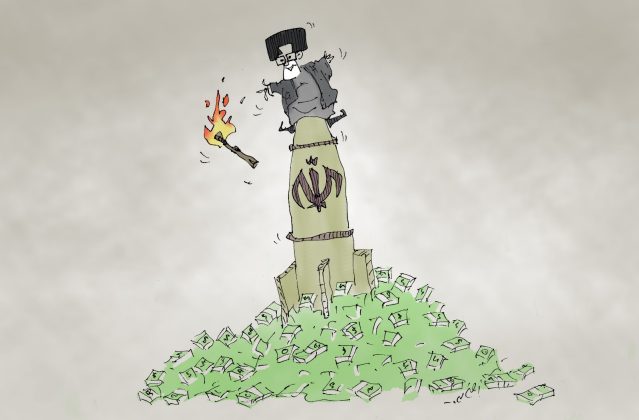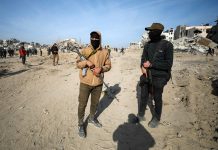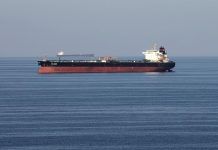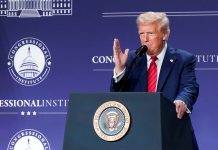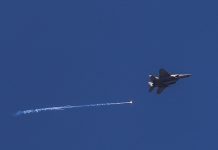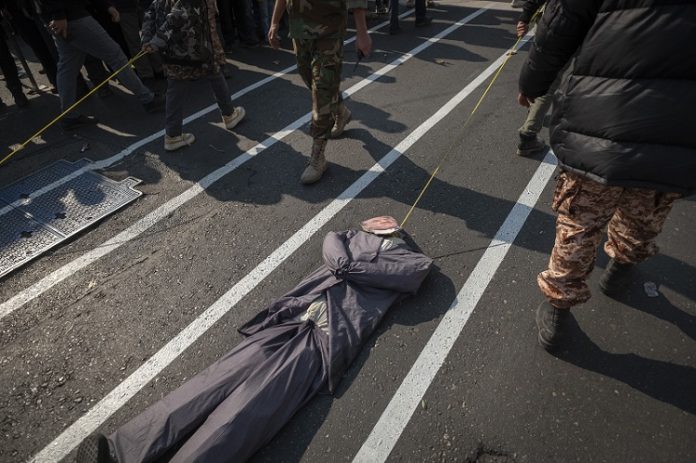
Forty-six years after the Islamic Revolution, which promised free water, electricity, and the distribution of oil wealth to the people, Iran’s economy is now facing one of its most critical moments.
The national currency, the rial, is rapidly losing value, and Iranians are growing poorer daily. Decreased foreign income, widespread capital flight, and crumbling infrastructure have severely undermined the country’s economic foundations.
Severe energy shortages have also significantly threatened the nation’s industries and production.
As Iranian government officials held ceremonies to commemorate the 46th anniversary of the 1979 Islamic Revolution and pro-government supporters burned images of the dollar in a symbolic gesture against the United States, the dollar’s value surged to a record-breaking 940,000 rials.
Alongside the dollar, the value of other foreign currencies and gold in Iran have also risen. The continuing increase in the dollar, often referred to as the “pulse of Iran’s economy,” is having a ripple effect on the price of goods and services, driving inflation higher across the country.
ANALYSIS: Collapsing Currency, Energy Shortages Hurt Iran’s Economy
Six months ago, when the reformist government led by President Masoud Pezeshkian took office, the dollar was valued at approximately 480,000 rials. Since then, its value has nearly doubled.
During this time, the Iranian rial has lost more than 50 percent of its value against the dollar. This drop in the rial’s value has effectively reduced the actual worth of wages and assets for citizens, making the Iranian population poorer.
This situation has led to a severe living crisis for low-income groups, including workers and retirees.
In October, when the dollar was valued at around 500,000 rials, calculations showed that workers’ and other minimum-wage earners’ incomes were barely sufficient to cover essential expenses for just one week of the month.
Recent statistics on Iranians’ income and nutrition indicate that 27 percent of the population survives on a daily income of only $2.
A study published on Feb. 2 in the Tehran-based Donya-e-Eghtesad newspaper revealed that 55 percent of urban residents in Iran faced food insecurity in 2024. Over the past two years, rising inflation and decreasing purchasing power have worsened the situation, with an increasing number of urban households experiencing food insecurity.
In an earlier report published in October 2024, the newspaper highlighted the adverse effects of malnutrition across various age groups.
It showed that 1.2 percent of children aged under five die of malnutrition or related causes; 4.1 percent of children over five suffer from severe malnutrition, as evidenced by low weight for their height; 5.3 percent of children are stunted due to chronic malnutrition; and 6.5 percent of Iranians are not receiving enough calories.
Additionally, the government’s misguided policies, such as securing foreign currency for importing medicine and animal feed, have contributed to significant price hikes in the pharmaceutical and food markets. From March 2024 to the end of January 2025, the prices of approximately 995 pharmaceutical and medical items have surged by 200 to 600 percent.
Reports suggest that many low-income households have been forced to remove medicines from their budgets due to the rising costs. Activists in the medical sector have also reported an increase in deaths among individuals suffering from specific and rare diseases, as they cannot afford the necessary treatments.
The prices of staple foods like rice, eggs, and potatoes — once the cornerstones of poor households’ diets — have soared, placing them at the forefront of rising food costs. As a result, the number of meals for low-income families is shrinking.
With no effective support programs for these groups, it remains uncertain how they will cope with the inflationary pressure driven by rising currency prices in the weeks ahead.
This situation has raised concerns among government analysts, who warn that the growing poverty and desperation to meet basic needs like food and housing could spark widespread protests nationwide.
A Weakened Iran Creates Hope for a Reset as Investors Return to the Middle East
One indication of the potential for protest was the strike and gathering of traders in Tehran’s Grand Bazaar on Feb. 4., following the government’s failure to address the soaring foreign currency rates and deepening market stagnation.
Meanwhile, various groups, including workers, retirees, teachers, and nurses, have been staging ongoing protests, holding demonstrations in front of the Majlis (Iranian Parliament), ministries, and other government institutions across multiple cities.
The Islamic Republic is grappling with more than just failing to stabilize the national currency and control inflation. It is facing deeper economic challenges.
A decline in oil and non-oil exports has significantly reduced foreign revenue, depleting the government’s treasury. This has stifled productive investments in the country, and the consequences have been dire.
One of the most striking effects has been the energy crisis, which has caused substantial damage.
Due to a lack of investment in the sector, the government cannot extract and distribute natural gas correctly, leading to a severe gas shortage in a country with the world’s second-largest reserves.
This has contributed to electricity shortages, as thermal power plants lack the necessary fuel. Additionally, producing key fuels like diesel, mazut (low-quality fuel oil primarily used in power plants), and gasoline is falling short of consumption demands.
A report from the Majlis Research Center, along with comments from Reza Ansari, CEO of the Small Industries and Industrial States Organization of Iran, reveals that last summer, power outages in industrial zones caused a loss exceeding $477 million due to the resulting revenue shortfall from production centers.
During the first half of this year, the government implemented electricity rationing for industrial and production units to address shortages in the residential sector.
However, simultaneous electricity and gas shortages have led to widespread outages across industrial, production, and agricultural sectors since the fall. As a result, many factories were forced to halt production for weeks, and some even had to reduce their workforce.
In several instances, power outages affected households and substantially damaged businesses in urban areas. The disruptions, which impacted sectors ranging from offices to manufacturing and services, have led to an estimated daily loss of $280 million.
Besides the reduced production caused by energy shortages, factors such as restrictive laws, internet censorship, sanctions, and Iran’s inclusion on the Financial Action Task Force (FATF) blacklist have all played a role in the decline of Iran’s foreign trade and industrial output.
Despite Supreme Leader Ali Khamenei’s long-standing goal of achieving 8 percent economic growth, a target set in the Five-Year Development Plan, Iran’s economy continues to grow at less than 3 percent, falling far short of the 8 percent goal.
In February 2020, the FATF blacklisted Iran for failing to enact the Palermo Convention (the United Nations Convention against Transnational Organized Crime), the Financing of Terrorism (CFT), and Anti-Money Laundering (AML), blocking Iran from international banking system transactions.
Iran’s “Seventh Five-Year Development Plan,” launched in 2023, focuses on critical areas such as economic growth, scientific and technological progress, and cultural development. It aims to achieve an average annual growth rate of approximately 8 percent over its duration.
Businesses in Iran face numerous obstacles, and low wages are key factors driving capital flight from the country.
Massoud Khansari, president of the Tehran Chamber of Commerce, Industries, Mines and Agriculture (TCCIMA), noted in December 2024 that between 2014 and 2022, around $10 billion left Iran annually due to official capital flight.
According to a late December 2024 report by the Tehran-based Ettelaat newspaper, private sector business leaders revealed that, over the previous year and a half, $70 billion in capital was moved abroad, primarily to Canada, from Iran’s industry and trade sectors alone.
Additionally, many businesses, including those in e-commerce and certain manufacturing sectors, have relocated their operations to neighboring countries for greater stability and freedom to continue their work.
Low wages, job insecurity, and the dominance of insider networks in public sector hiring, combined with limited social freedoms and the oppressive security measures imposed by the government, have led to a swift and widespread departure of human capital from the country.
Migration from Iran, once primarily limited to intellectuals, now encompasses graduates from various academic disciplines, medical professionals, engineers, skilled workers, artists, and artisans. These individuals are leaving Iran for better opportunities to work and live in countries that will offer them a future.
The ongoing loss of Iran’s professional workforce has sparked concern among experts and government officials, yet the Islamic Republic has taken no meaningful action to retain its citizens.
The 46 years of the Islamic Republic’s rule have not only altered Iran’s economic trajectory but have also pushed the country’s infrastructure and resources toward hyperinflation, with a looming risk of economic collapse in the coming months.
For the Islamic Republic, the only viable solution appears to be to engage in constructive negotiations with U.S. President Donald Trump, get sanctions lifted, and take steps to remove Iran from the FATF blacklist.

